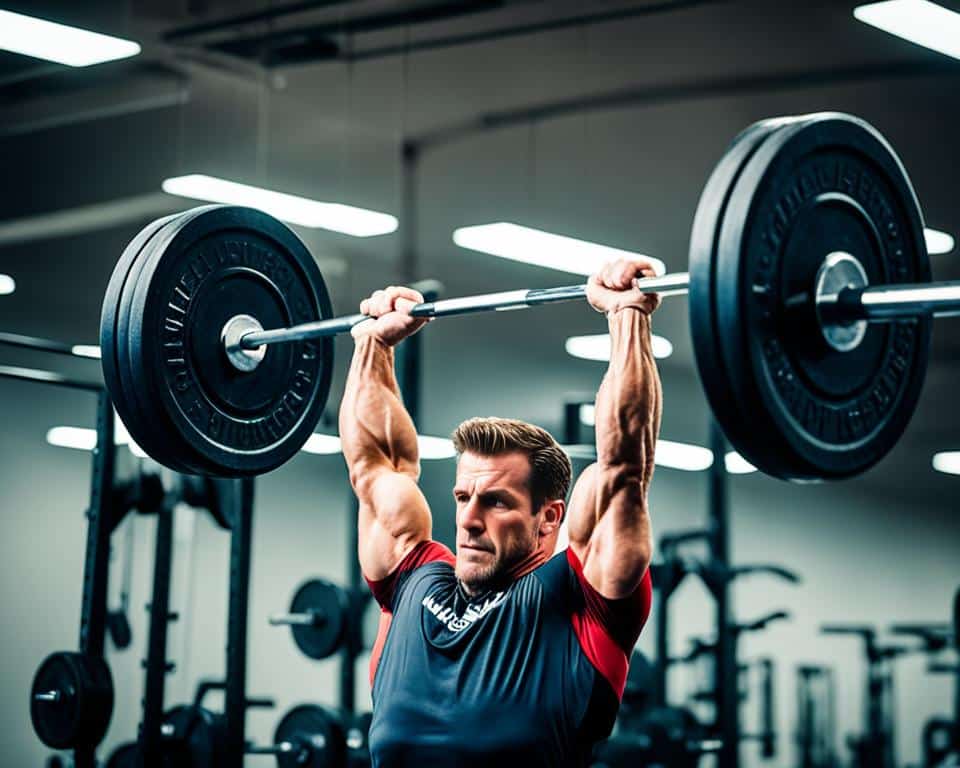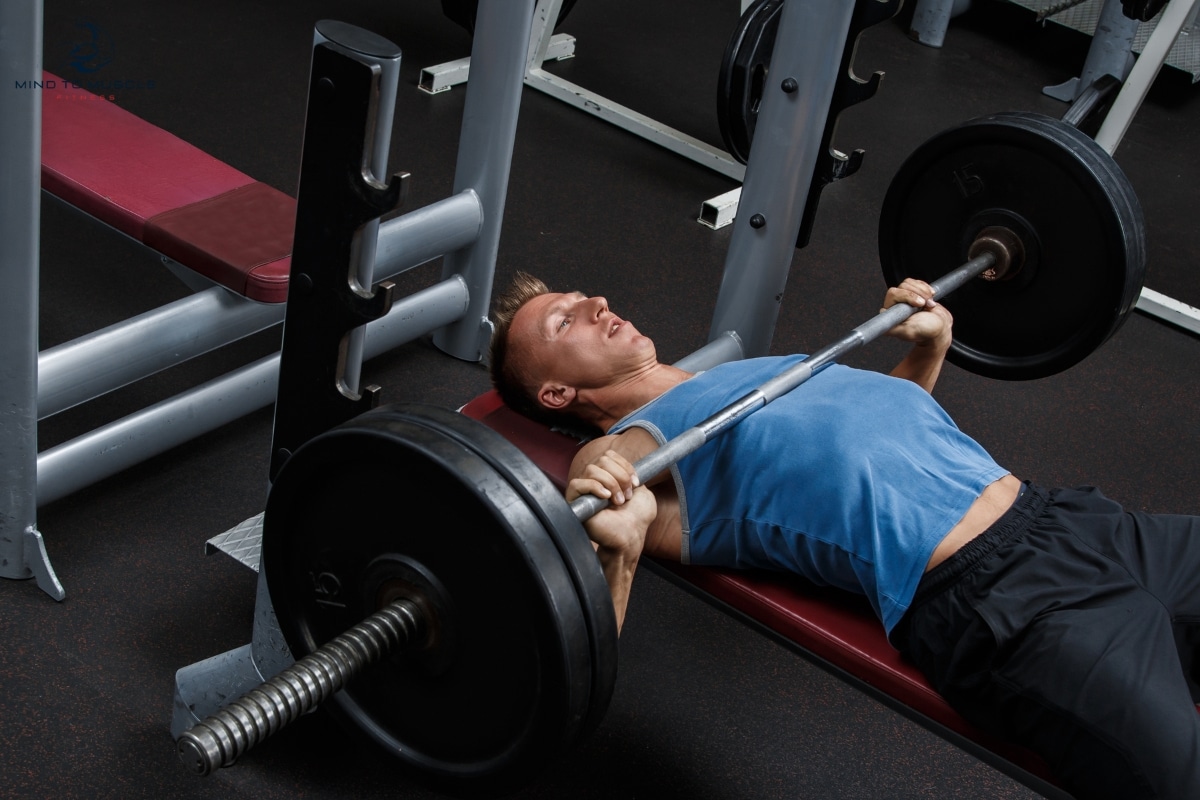
Maximize Gains with Effective Negative Reps Training
Did you know men can push roughly twice as strong as they can pull? But focusing on negatives—a type of eccentric exercise—could change the game in building muscle. This method isn’t just about lifting weights. It’s also about how you lower them. This underappreciated part of strength training can level up your workout. Using negatives not only works out key muscles but also boosts your grip strength.
My fitness journey showed me something important. Studies say adding negatives can build muscle better than traditional workouts. I want to make this advanced info easy for you. Let me turn complex science into practical tips for your exercises.
It’s important to keep a balance between pushing and pulling in your workouts. This balance helps avoid muscle imbalances and possible injuries. I’m here to blend science into your weightlifting, aiming for lasting fitness success.
Key Takeaways
- Negatives, key to muscle building, hinge on the eccentric phase of movement that demands muscle lengthening.
- Eccentric exercises boost the muscles needed for a full pull-up, improving functional fitness skills.
- Enhancing grip strength through negatives complements overall workout performance.
- Maintaining a balanced workout regimen prevents overuse injuries and ensures muscle symmetry in strength training.
- Research confirms that both high and low-load resistance training can lead to significant muscle hypertrophy.
- Understanding the nuances of pushing versus pulling exercises can create a more rounded fitness approach for both men and women.
Unlocking the Power of Eccentric Training
Eccentric training is key for muscle and strength growth. It’s where your muscles stretch while holding weight. This method is great for improving your technique and building muscle.
Understanding Eccentric vs Concentric Movements
Exercises have two parts: lifting (concentric) and lowering (eccentric). Both parts are important. But the eccentric part can really help muscle growth. Introducing negatives into your routine brings new challenges, helping you keep getting stronger.
The Hidden Strength in Each Lift: Exploring Muscle Tension and Lengthening
Eccentric training focuses on the ‘negative’ phase, increasing muscle tension. This way, you engage more muscle fibers, boosting strength significantly. Research shows it can up muscle strength by 175% during this phase.
With eccentric exercises, you can lift much more—about 120-175% of your one-rep max in specific moves. This intense engagement leads to bigger muscle growth than concentric training. Also, they’re more energy-efficient, allowing for more sets and reps.
Heavy negatives bring many long-term perks. They improve muscle recruitment and stimulate growth hormones. This means better muscle gains today and more strength for future workouts.
Slow, controlled negatives also improve your flexibility and tendon strength. This can help prevent injuries. Eccentric training boosts your overall athletic abilities, making you faster, stronger, and more resilient after intense workouts.
In summary, include eccentric training in your workouts to see major gains. It’s where real strength lies quietly, waiting for you to unlock it.
Why Embrace Negative Reps in Your Routine?
When we talk about being inclusive in training, we’re aiming higher. It’s not just the usual workouts. We’re bringing in special tactics like negative reps. These help you reach your fitness goals and get strong quicker. The success stories, like Akim Williams and his 550-pound bench press, prove it. His achievements and those of many others show that negative reps work.
Turning the Tables: How Negatives Lead to Positives in Fitness
I’ve seen it in the gym and heard it from pros like Elliott Hulse. Negative reps take you on a unique path to stronger muscles. Hulse’s approach could add 35 pounds to your bench press in just eight weeks. By focusing on form and these reps, your muscles face new challenges. They become ready for more weight over time.
Negative self-talk, turned positive, can also uplift your performance. It shows how what seems bad can actually help grow your mind and body.
More than Just Muscle: The Systemic Benefits of Eccentric Focus
Negative reps do more than build muscle. They make you move better and safely. They’re key for long-term strength and help avoid injuries. They also strengthen ligaments and tendons. This helps you overcome your limits.
Now, let’s look at the evidence. Here’s a summary of why negative reps are great, based on current studies and programs:
| Benefit | Details |
|---|---|
| Muscle Growth | Results in greater tension, leading to hypertrophy |
| Strength Improvement | Elliott Hulse’s program – potential 35-pound increase to max bench press |
| Cognitive Perks | Improved performance through refined internal motivation (research) |
| Anxiety Management | Reframing negative self-talk boosts confidence (research) |
Embrace the process with negative reps and see your fitness dreams come true. Remember, how you lower the weight matters just as much as lifting it.
Mastering the Mechanics of Negative Reps
Negative reps are more than a fitness fad—they’re scientifically backed. Research in Ergonomics highlights how eccentric training boosts muscle performance. This means focusing on the lowering phase of exercises can revolutionize your training.
Doing negative reps taps into your muscles’ power when they stretch. This method values control over speed. As you lower weights, you’re showcasing strength and precision. This applies to squats, bench presses, and bicep curls alike, emphasizing slow descent and full muscle focus.
Negative rep techniques aren’t just for pro athletes. They’re for everyone, whether you train alone or with a partner. Let’s look into the studies:
| Year | Study | Focus |
|---|---|---|
| 1972 | Eccentric and Concentric Muscle Conditioning | Muscle Tension and Activity |
| 1974 | Elastic Energy Storage in Muscles | Skeletal Muscle Function |
| 1987 | Exercise-Induced Muscle Damage | Muscle Adaptations |
| 2006 | Neuromuscular Fatigue and Stretch-Shortening Cycle | Resistance Training Models |
| 2008 | Plyometric Intensity Analysis | Electromyography Studies |
Emphasizing the eccentric phase strengthens and conditions your body. It prepares you for tougher physical tasks. Think of this as not just lifting, but sculpting your strength. Let’s aim to train smarter with precise negative reps, enhancing our journey to build muscle.
Creating an Effective Training Program with Negative Reps
Starting a journey to improve workout efficiency through negative reps is exciting. It’s important to build a training program that fits your level. Whether you’re a beginner or advanced, adding negative reps can boost your fitness results. Let’s look at how to add this powerful method to your routine.

The Beginners Blueprint: Incorporating Negatives Slowly
If you’re new to strength training, adding negative reps slowly is key. Start with familiar exercises, making the lowering phase longer. For example, in a bicep curl, slowly lower the weight in three to five seconds. This approach strengthens muscles and prepares you for more complex techniques. Check out trusted sources for more on the benefits.
Advanced Techniques: Scaling Up with Spotter-Assisted Negatives
When you’re ready, increase the challenge with spotter-assisted negative reps. A spotter helps you lift the weight, letting you focus on the lowering motion. This method is great for overcoming workout plateaus and strengthening your muscles.
Programming Tips: Avoiding Overtraining and Injury
A good training program balances muscle stress and recovery. Carefully add negative reps and allow your body to rest. Aim for negative rep sessions once or twice a week. Combine this with proper nutrition and sleep for recovery. Spread out your workouts to keep efficient without overdoing it. This approach reduces injury risks and helps muscle growth, as studies suggest. Consistency and progression are key to long-term success, so regularly adjust the intensity and volume of your workouts based on your goals. Incorporating reverse pyramid training tips, such as starting with heavier weights and gradually reducing the load with each set, can maximize strength gains while maintaining proper form. Remember to listen to your body, as overtraining can hinder progress and lead to setbacks.
Quantifying the Gain: Research-Backed Advantages
Understanding muscle building and strength training isn’t just about doing workouts. It’s also knowing the science behind it. The technique of negative reps is well-studied. It shows us how muscles work and how they grow.
Adding negative reps to your workouts does more than build muscle. It improves your Rate of Force Development (RFD). This is key for sports performance. Athletes with high RFD perform better because they can use their strength quickly.
But it’s not enough to know RFD matters. Measuring it shows how training like resistance and ballistic workouts can boost RFD. Exercises that focus on quick movements are best for sports that need sudden power, like jumping or sprinting.
Studies show negative reps lead to significant muscle and strength gains. These gains are measured with precise numbers, showing how effective this method is.
- Research from 2009 found that negative reps bring many benefits. These include better hormone responses, more strength, and muscle growth.
- A 2015 study showed the importance of how much and how often you do negative reps for the best strength gains.
- In 2013, a study highlighted that you need a certain level of intensity in your workouts. Without it, you won’t see the muscle growth you’re aiming for.
Negative reps should be a key part of your workout plan. This advice comes from solid research. It helps you build muscle and strength the right way. This knowledge lets you shape your body both scientifically and aesthetically.
Real Gym Stories: Success with Negative Reps Training
Negative reps have changed the game for many fitness lovers. These stories highlight how adding negative reps to workouts made a big difference. People saw better performance, muscle growth, and overall fitness improvement.
Negative reps catch the interest of anyone looking to improve. This technique boosts muscle endurance and breaks through plateaus. We will look at how real-life success stories are linked to negative reps.
Testimonials: Lifters Who Have Transformed Their Workouts
Many gym-goers say that negative reps have transformed their training. They’ve gone beyond their limits and set new strength records. This shows how focusing on eccentric training changes regular workouts.
Analyzing Real-World Examples: How Negative Reps Push Limits
A group of lifters saw big benefits from negative reps. They improved physically and mentally. Focusing on the downward motion and muscle tension led to bigger muscles and stronger lifts across different ages.
In my coaching, I’ve seen clients improve with negative reps. Through steady progress, following safety, and watching for overtraining, their workouts went from normal to amazing.
Conclusion
Eccentric training is more than a small part of muscle building. It’s a major headline. Studies show it leads to big muscle gains fast. For example, the Colorado Experiment saw Casey Viator gain 63 pounds of muscle in just a month. That’s way faster than the usual 5-10 pounds a year.
This kind of training does more than just add muscle. It also includes things like flywheel resistance training. These methods improve sports performance and muscle activation better than traditional weight lifting. They help athletes, like professional handball players, get better in their sports. They also allow for stronger muscles with less effort and better control after an injury.
If you’re looking to get stronger, using negative reps could be your secret weapon. This approach works well across many sports, showing it’s great for everyone. Whether you’re just starting or trying to reach new heights in muscle building, eccentric training can help. It’s a key to unlocking new levels of fitness and physical power. That’s the exciting future of fitness we see today.
FAQ
What exactly are negative reps in strength training?
Negative reps are part of the exercise where you lower the weight slowly. This focuses on the muscle lengthening phase, not the shortening phase. Doing this can help you build more muscle and get stronger.
How do eccentric and concentric movements differ?
Eccentric and concentric movements are different in how the muscle works. In concentric movements, your muscle gets shorter as it lifts a weight. But with eccentric movements, the muscle stretches as you lower the weight. Both types are important but eccentric ones help more with muscle growth and control.
Why should I include negative reps in my workout routine?
Adding negative reps to your workout can help you gain more muscle and get stronger. They make your workouts tougher and improve your lifting skills. These reps also cut down the chance of getting hurt, boost flexibility, and can help when you’re stuck in your training.
How do I perform negative reps correctly?
For correct negative reps, focus on lowering the weight slowly. Use a controlled speed to fight gravity and gently lower the weight. This makes your muscles work harder and longer, which is great for building strength and muscles.
How can beginners incorporate negative reps into their training?
Beginners should use a light weight and lower it slowly. It’s key to keep good form and slowly up the time and intensity of the negative part. This helps muscles get used to it safely and builds strength.
What advanced techniques involve negative reps?
Advanced lifters can try spotter-assisted negative reps. Here, you lower a heavier weight than you can lift on your own. A spoter assists on the lift so you can focus on lowering the weight carefully. This boosts the workout for the eccentric part.
How can I prevent overtraining and injury when doing negative reps?
To avoid overtraining and getting hurt, listen to your body and rest well between workouts. Mix negative reps and other exercises carefully to allow recovery. Always use proper form and don’t increase weight too quickly. Stop if something feels wrong.
What has research shown about the benefits of negative reps?
Studies show negative reps are very good for building muscle and strength. Muscles can handle more weight and get damaged in a good way, which helps them grow. So, adding negative reps to workouts can really boost muscle size and strength.
Are there real-life success stories from lifters using negative reps?
Yes, lots of lifters have seen big benefits from using negative reps. They’ve got stronger and their muscles have grown. By focusing on the lowering phase, they’ve broken personal records and moved past limits in size and strength.



